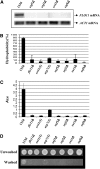Identification of novel activation mechanisms for FLO11 regulation in Saccharomyces cerevisiae
- PMID: 18202364
- PMCID: PMC2206066
- DOI: 10.1534/genetics.107.081315
Identification of novel activation mechanisms for FLO11 regulation in Saccharomyces cerevisiae
Abstract
Adhesins play a central role in the cellular response of eukaryotic microorganisms to their host environment. In pathogens such as Candida spp. and other fungi, adhesins are responsible for adherence to mammalian tissues, and in Saccharomyces spp. yeasts also confer adherence to solid surfaces and to other yeast cells. The analysis of FLO11, the main adhesin identified in Saccharomyces cerevisiae, has revealed complex mechanisms, involving both genetic and epigenetic regulation, governing the expression of this critical gene. We designed a genomewide screen to identify new regulators of this pivotal adhesin in budding yeasts. We took advantage of a specific FLO11 allele that confers very high levels of FLO11 expression to wild "flor" strains of S. cerevisiae. We screened for mutants that abrogated the increased FLO11 expression of this allele using the loss of the characteristic fluffy-colony phenotype and a reporter plasmid containing GFP controlled by the same FLO11 promoter. Using this approach, we isolated several genes whose function was essential to maintain the expression of FLO11. In addition to previously characterized activators, we identified a number of novel FLO11 activators, which reveal the pH response pathway and chromatin-remodeling complexes as central elements involved in FLO11 activation.
Figures






Similar articles
-
Chromatin modulation at the FLO11 promoter of Saccharomyces cerevisiae by HDAC and Swi/Snf complexes.Genetics. 2012 Jul;191(3):791-803. doi: 10.1534/genetics.112.140301. Epub 2012 Apr 27. Genetics. 2012. PMID: 22542969 Free PMC article.
-
Coding repeat instability in the FLO11 gene of Saccharomyces yeasts.Yeast. 2008 Dec;25(12):879-89. doi: 10.1002/yea.1642. Yeast. 2008. PMID: 19160455
-
Amino acid transporter genes are essential for FLO11-dependent and FLO11-independent biofilm formation and invasive growth in Saccharomyces cerevisiae.PLoS One. 2012;7(7):e41272. doi: 10.1371/journal.pone.0041272. Epub 2012 Jul 26. PLoS One. 2012. PMID: 22844449 Free PMC article.
-
Flor yeasts of Saccharomyces cerevisiae--their ecology, genetics and metabolism.Int J Food Microbiol. 2013 Oct 15;167(2):269-75. doi: 10.1016/j.ijfoodmicro.2013.08.021. Epub 2013 Sep 10. Int J Food Microbiol. 2013. PMID: 24141073 Review.
-
FLO11, a Developmental Gene Conferring Impressive Adaptive Plasticity to the Yeast Saccharomyces cerevisiae.Pathogens. 2021 Nov 19;10(11):1509. doi: 10.3390/pathogens10111509. Pathogens. 2021. PMID: 34832664 Free PMC article. Review.
Cited by
-
Selection of an autochthonous Saccharomyces strain starter for alcoholic fermentation of Sherry base wines.J Ind Microbiol Biotechnol. 2013 Jun;40(6):613-23. doi: 10.1007/s10295-013-1251-0. Epub 2013 Apr 2. J Ind Microbiol Biotechnol. 2013. PMID: 23546810
-
Role of Mitochondrial Retrograde Pathway in Regulating Ethanol-Inducible Filamentous Growth in Yeast.Front Physiol. 2017 Mar 29;8:148. doi: 10.3389/fphys.2017.00148. eCollection 2017. Front Physiol. 2017. PMID: 28424625 Free PMC article.
-
A Gβ protein and the TupA Co-Regulator Bind to Protein Kinase A Tpk2 to Act as Antagonistic Molecular Switches of Fungal Morphological Changes.PLoS One. 2015 Sep 3;10(9):e0136866. doi: 10.1371/journal.pone.0136866. eCollection 2015. PLoS One. 2015. PMID: 26334875 Free PMC article.
-
A brief overview of the Swi1 prion-[SWI+].FEMS Yeast Res. 2018 Sep 1;18(6):foy061. doi: 10.1093/femsyr/foy061. FEMS Yeast Res. 2018. PMID: 29905794 Free PMC article. Review.
-
Analysis of [SWI+ ] formation and propagation events.Mol Microbiol. 2017 Apr;104(1):105-124. doi: 10.1111/mmi.13616. Epub 2017 Jan 26. Mol Microbiol. 2017. PMID: 28035761 Free PMC article.
References
-
- Bayly, J. C., L. M. Douglas, I. S. Pretorius, F. F. Bauer and A. M. Dranginis, 2005. Characteristics of Flo11-dependent flocculation in Saccharomyces cerevisiae. FEMS Yeast Res. 5: 1151–1156. - PubMed
-
- Bjorklund, S., and C. M. Gustafsson, 2005. The yeast Mediator complex and its regulation. Trends Biochem. Sci. 30: 240–244. - PubMed
-
- Boukaba, A., E. I. Georgieva, F. A. Myers, A. W. Thorne, G. Lopez-Rodas et al., 2004. A short-range gradient of histone H3 acetylation and Tup1p redistribution at the promoter of the Saccharomyces cerevisiae SUC2 gene. J. Biol. Chem. 279: 7678–7684. - PubMed
Publication types
MeSH terms
Substances
LinkOut - more resources
Full Text Sources
Other Literature Sources
Molecular Biology Databases
Miscellaneous

